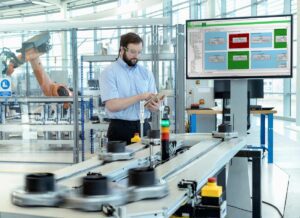As we emerge from the demand constrained world of the past few years into the fast-paced, uncertain supply constrained world of today (and probably the near future) companies are examining production assets more closely than ever before. Production machines typically represent 75% of the capital spend on a production facility so you can bet they are under a microscope; How quickly can they generate value? And what returns can they generate for the business over the long haul?
End customers turn to their production machinery suppliers or OEMs in their quest for new ideas to improve their operational effectiveness and agility. OEMs are experts in processes machinery and specialists in the industries they serve. Who better to ensure that production machinery is up and running faster and performing more effectively?
Automation systems are at the heart of it all and IIoT is playing an ever-increasing role. There are three critical phases of a machine’s life cycle: design, commissioning and operations. How can technology providers like Schneider Electric and OEMs help end users get the most of their assets during each of these three phases, in terms of performance and profitability? Let’s illustrate with two case studies involving OEMs who build machines for the Food & Beverage industry.
Engineering application knowledge and scalability make for high performance machines
Recently, we worked with a customer on a milk bottle filling capping machine. The first thing to say is that capping is not a trivial thing. The application involves both speed and accuracy, which requires highly capable motion control. In particular, torque precision is critical in achieving the right seal. Too much torque and the cap will twist off the bottle all together, which leads to inefficiency and waste. Not enough torque and the seal may be insufficient, a risk for food safety. As they say, there’s no use crying over spilt milk, but our end users may well indeed cry over spoiled milk.
This all calls for our scalable PacDrive3 Automation System, with high performance and reliability. The torque precision is superior to most, and from a programming perspective it’s easy change the number of capping heads. I don’t have to tell you how important scalability is to manufacturers considering current supply chain challenges.
But a high performing, flexible machine is only one part of the story. The other part is the engineer’s thorough understanding of the capping application used in conjunction with our libraries. This foundational knowledge significantly increases engineering efficiency, which fast-tracks the design and engineering phase, and in turn improves commissioning as well. This all reduces time to market and guarantees the performance of the final machine.
Generate new avenues for business growth with remote monitoring services
Clearly digitization provides a lot of opportunities for improvement during the engineering and commissioning phases of a machine’s life cycle. It also helps during operation too. We have another example of this with a recent project for a chocolate molding machine and cooling tunnel. As well as full programming and commissioning support, one of the software solutions implemented was EcoStruxure Secure Connect Advisor, which enables remote monitoring capabilities. This is basically the equivalent of IT being able to remote in to your computer and tell you what’s wrong with it instead of having to describe it over the phone.
This function is one of the game changing benefits of digitization whose adoption has accelerated in recent years when travel was restricted. Experts can cyber securely connect to the machine from anywhere in the world and diagnose or troubleshoot from afar in real time. Information doesn’t get lost in translation because they can see it clearly. It saves the OEM time and cost so they can work on their next job rather than travel to site. For the end user downtime is reduced and there’s no need to wait for help to arrive. It also allows for advanced monitoring of assets, which enables predictive maintenance and further reduces unplanned downtime. It really is a no-brainer.
For the OEM, in particular, it provides even more opportunities for business growth in new areas. Typically, a machine may spend up to six months in the hands of the OEM before it leaves to spend another ten years or so with the manufacturer. But what if it were possible to extend the customer relationship beyond the development phase after the machine has been delivered to the end user? Remote connection does this by allowing OEMs to provide long term enhanced technical support as a trusted advisor. On top of maintenance and troubleshooting, they can also use diagnostics to help end users improve the performance of the machine overall. This enables them to include the operational phase of the machine in their business model, opening up more avenues for revenue.
Digitization provides scope for improvement during all stages of a machine’s life cycle. It’s clear both the manufacturer and the OEM are winners when each stage becomes more efficient. That’s why we continually strive to push the limits, ensuring our technology helps build high performing machines that bring more value to customers and end users.



